|
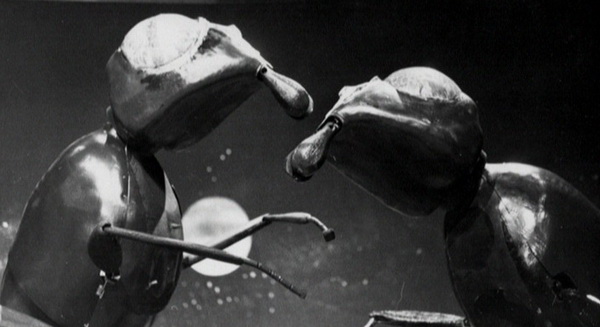
The Web Planet
13TH FEBRUARY 1965 - 20TH
MARCH 1965
(6 EPISODES)
1. THE WEB PLANET
2. THE ZARBI 3. ESCAPE TO DANGER
4. CRATER OF NEEDLES
5. INVASION 6. THE CENTRE



Apparently The
Web Planet attracted 12.6 million viewers over its six-week run
in 1965. The
word ‘how?’ immediately springs to mind. Just as incredibly, this serial
has been chosen as the third complete William Hartnell serial for DVD
release, ahead of the likes of The Daleks and The Tenth Planet.
And whilst the disc may come beautifully dressed in striking purple and
blue artwork, that’s about all that’s good about it.
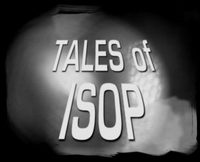 So
far as special features go, the disc is pretty bleak save for the
half-decent Tales of Isop documentary. William Russell reads a
story from the first Doctor Who annual, The Lair of Zarbi
Supremo; we are treated to some Give-A-Show Slides; there is a
photo gallery; a commentary; and, of course, the deal-clinching PDF
version of the apposite Doctor Who annual. It’s terribly poor in
comparison to recent releases. So
far as special features go, the disc is pretty bleak save for the
half-decent Tales of Isop documentary. William Russell reads a
story from the first Doctor Who annual, The Lair of Zarbi
Supremo; we are treated to some Give-A-Show Slides; there is a
photo gallery; a commentary; and, of course, the deal-clinching PDF
version of the apposite Doctor Who annual. It’s terribly poor in
comparison to recent releases.
Where
this DVD really falls down though is in its meat – the six episodes of
The Web Planet itself. Bill Strutton’s script had a lot of vision and
a lot of potential, and whilst some of that potential is realised on
screen, the serial is too poorly paced to hold a viewer’s attention at
all, never mind be regarded as a classic. I was particularly disappointed
with this story because it had been so hyped up to me: the Zarbi
notoriously made my Uncle Mick hide behind the sofa when he was a child.
Distant members of my family would always say “Watch the one with the
Zarbi in it” when they learned that I liked Doctor Who, but I could
never get seem to get hold of the two-part VHS release and I always seemed
to miss the UK Gold repeat, so until its DVD release The Web
Planet was one of a handful of Doctor Who television stories
that I’d never seen (or heard). After restlessly sitting through all six
episodes earlier this afternoon in one sitting, driving my fiancée out of
the flat, hearing Hartnell fluff far more than usual and enduring the
absolute worst Who costumes and special effects of all time, I’m
now convinced that it was providence that I’d missed out on this story for
so long.
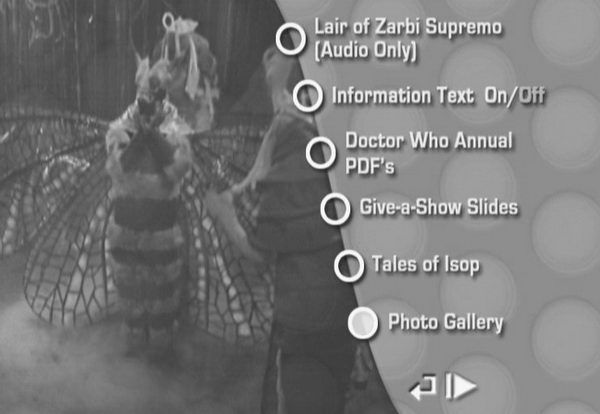
Above: The DVD's (much more
limited than usual) selection of special features
 On the plus side, The Web Planet is
at least visually distinctive
in that the director’s ‘Vaseline on the camera’ trick actually succeeds in
creating a very alien atmosphere. Episode 1, the titular
“Web Planet”,
is quite easily the pick of the bunch for this reason, despite being quite
similar in plot to
“The Dead Planet”. However, from there the serial
deteriorates into farce. Grubs that dance about and sound like Native
Americans. The laughable Menoptra. And as for the infamous Zarbi, I can’t
wait to see what our Mick says when he sees this. On the plus side, The Web Planet is
at least visually distinctive
in that the director’s ‘Vaseline on the camera’ trick actually succeeds in
creating a very alien atmosphere. Episode 1, the titular
“Web Planet”,
is quite easily the pick of the bunch for this reason, despite being quite
similar in plot to
“The Dead Planet”. However, from there the serial
deteriorates into farce. Grubs that dance about and sound like Native
Americans. The laughable Menoptra. And as for the infamous Zarbi, I can’t
wait to see what our Mick says when he sees this.
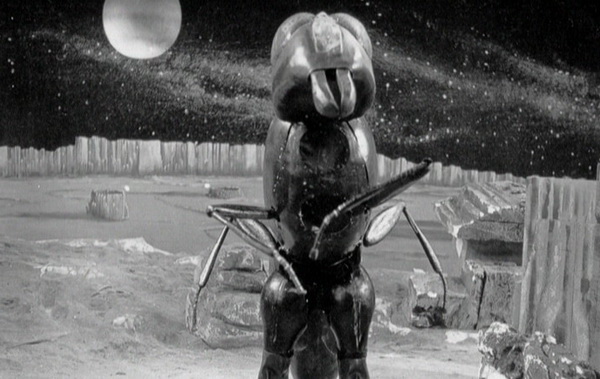
For me then, The Web Planet is asking me to stretch my disbelief
just ever so slightly too far. Even in its day, despite the high viewing
figures, it was regarded as “a third rate kiddies’ pantomime.” Were it a
four-part story made over a longer period of time, then my opinion might
well be a little more favourable – but as a six-parter full of padding,
bashed out by the Beeb on no money in six weeks? It’s no surprise that it
doesn’t stand up too well in 2005.
|
|
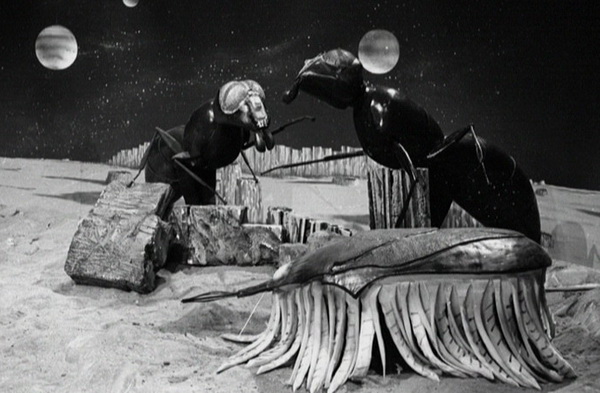
Doctor Who
and the Zarbi



The second of the original three
novelisations that eventually led to the Target range,Doctor Who and
the Zarbi is based fairly faithfully upon the serial The Web
Planet. The main development of the narrative is much the same, with Bill Strutton’s effective prose style
fleshing out the world of Vortis, giving
it a sense of otherworldly realism. The planet and its inhabitants really benefit
from being described in print – though the original serial was an
astonishingly impressive effort, the level of make-up and effects
available was never going to be up to the
task of convincingly portraying a world of insects. With prose description
to kick-start the imagination, however, the reader or listener can
visualise far more credible creatures. The Zarbi, singled out as the
titular monster in this tale, particularly come
across better here, being described in genuinely unsettling terms on some
occasions. Equally, the Animus, the true villain of the piece, despite
being described as a spider by the Doctor, is portrayed as something much
more impressive than the whiskery prop of the original – it’s now a
glowing nucleus, described in unpleasantly biological terms… although the
choice of the word ‘bladder’ to describe it was perhaps not the wisest.
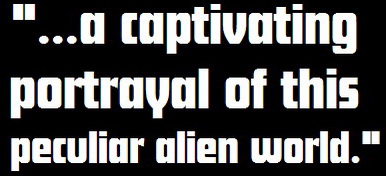 Equally, the
plot is improved by the greater level of characterisation afforded by the
novel form. The main characters come off well, particularly the Doctor
(referred to as ‘Doctor Who’ throughout), and Ian, both of whom lead significant portions of the story as the plot breaks the characters
up to continue separate adventures on the planet. Although there are some
elaborations on the plot seen on television, the story is essentially
unchanged, and this does mean that it drags woefully in the middle, just
as the original did. Once the curiosity aroused by Vortis is satisfied,
there’s a long wait before the main events of the plot really kick-in.
There’s a good deal too much talking plans through in the fourth and fifth
chapters, when what we really want is to get down to action of the final
infiltration of the Animus’s web. Equally, the
plot is improved by the greater level of characterisation afforded by the
novel form. The main characters come off well, particularly the Doctor
(referred to as ‘Doctor Who’ throughout), and Ian, both of whom lead significant portions of the story as the plot breaks the characters
up to continue separate adventures on the planet. Although there are some
elaborations on the plot seen on television, the story is essentially
unchanged, and this does mean that it drags woefully in the middle, just
as the original did. Once the curiosity aroused by Vortis is satisfied,
there’s a long wait before the main events of the plot really kick-in.
There’s a good deal too much talking plans through in the fourth and fifth
chapters, when what we really want is to get down to action of the final
infiltration of the Animus’s web.
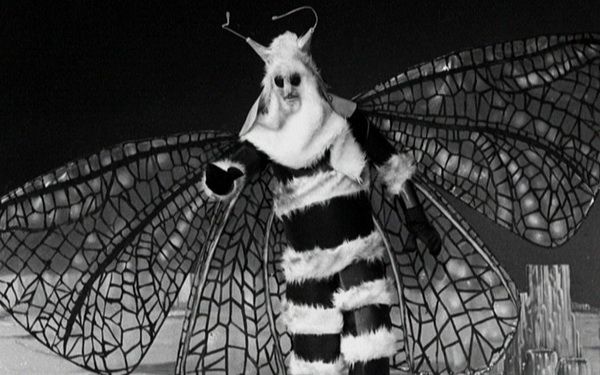
William Russell
once again provides an excellent reading. His voice seems perfectly suited
to the spooky atmosphere evoked here. Naturally, his portrayal of Ian is
note-perfect, and his version of the Doctor is also very good, somewhat closer
to the original than his attempt in Doctor Who and the Daleks,
though this is as
much due to the writing as his performance. Less convincing are
Barbara and especially Vicki, though it’s hardly fair to expect an exact
performance as a young woman from a man in his late seventies. The
secondary character voices are excellent, more so than those in the
original serial – the Menoptera (sic) speak in noble tones, treated
with a subtle modulation, while their Optera cousins are a lot more coherent
here than the originals. The Animus is particularly impressive – although
I liked the silky, feminine tones of the original, the arrogant booming
voice here gives a real sense of power and threat. Add to this some highly
effective sound work, such as the chittering of the Zarbi and the
fluttering of the Menoptera’s wings, and you have a captivating portrayal
of this peculiar alien world.
|
|
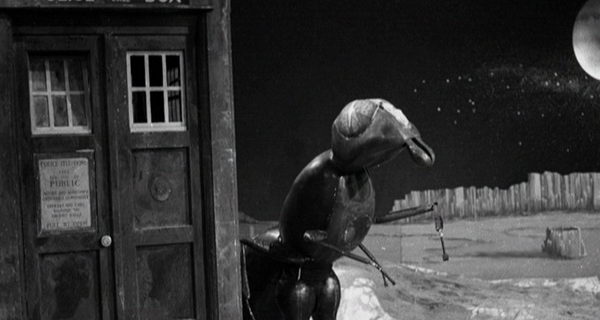



Every now and again I get an
itch to watch every single Doctor Who story, and when I
start to scratch it, early classics such as Marco Polo and The
Aztecs fuel my desire
to see the thing through. Season 2, however, has always given me pause,
and no serial more so than The Web Planet – a serial so reviled
that it holds the unwelcome distinction
of the being the only classic series DVD that I didn’t watch as soon as
I’d bought it. This is the story that About Time claims looks like
1920s television. The story where a Zarbi walks straight into the camera.
The story where producer Verity Lambert had to write to director Richard
Martin to tell the cast to stop mucking about with the script. This story
is generally considered the absolute nadir of Doctor Who.
Yet I’m starting to think that we might have all got it wrong. My problem
with this serial has always been in trying to watch the whole thing
through without any breaks - television suicide, as my colleague Mr
Wolverson will attest (see above). But such is the case with many a
six-parter, with even mighty classics such as Genesis of the Daleks
and The Seeds of Doom suffering the same curse. No – the best way
to experience The Web Planet to cut it up and sip it like a fine
wine, late at night after all potential detractors have gone to bed.
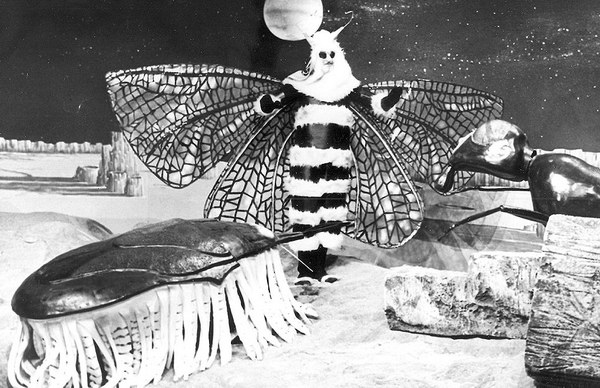
.jpg) I
want to start by discussing the serial’s
ambition. “An ambitious
failure,” lots of people call it. After Planet of Giants, The Dalek Invasion of Earth
and The Romans, only a fool would think
that
production team were going to play it safe, but The Web Planet
is probably the most powerful testament to just how far they were
willing to go to try new things. Unlike the CG worlds of Gridlock,
this was uncharted, dangerous territory because it could have
wound up looking ridiculously amateurish and putting the brakes
on any further adventures of this nature. The fact that Lambert and
Martin were willing to risk the ridicule is marvellous, and they truly
went for it 1960s style, giving it everything that they had. I really
admire that. I
want to start by discussing the serial’s
ambition. “An ambitious
failure,” lots of people call it. After Planet of Giants, The Dalek Invasion of Earth
and The Romans, only a fool would think
that
production team were going to play it safe, but The Web Planet
is probably the most powerful testament to just how far they were
willing to go to try new things. Unlike the CG worlds of Gridlock,
this was uncharted, dangerous territory because it could have
wound up looking ridiculously amateurish and putting the brakes
on any further adventures of this nature. The fact that Lambert and
Martin were willing to risk the ridicule is marvellous, and they truly
went for it 1960s style, giving it everything that they had. I really
admire that.
You might complain about the creaky, clanking sets but this was an attempt
to transport the Doctor and his friends to a truly alien world. Besides, I
think that the sets are terrific - nothing is as you expect it should be.
We have gorgeous looking moons in the sky, a craggy planet surface
stretching for miles, acid pools, the Crater of Needles, rock formations
allowing the camera to shoot from all angles, trippy Zarbi headquarters,
and even the cancerous Animus sucking in all the goodness out of the
planet with its light. The underground bases, houses, museums, and sewers
of The Dalek Invasion of Earth were all child’s play to visualise,
but Vortis is a dark and menacing environment for our regulars to lose
themselves within. Here literally anything can happen - giant ants might
swarm, or moths soar down from the sky. You might fault the realisation
given the standards of today, but you have to at least appreciate the care
that has gone into making this as strange and uncomfortable a setting as
it could possibly have been.
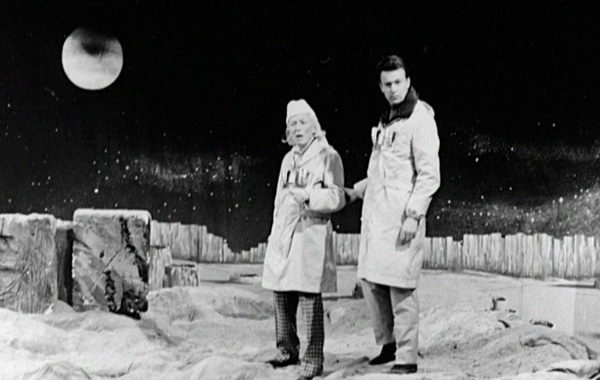
The infamous Zarbi costumes actually look rather good, genuinely
resembling horrid ants with curiously photographable faces (so much so
that cameras come zooming up to them and don’t stop!). Admittedly the
Menoptra look like they’re wearing pyjamas, but again their faces are very
effective - my husband Simon has a morbid fear of moths, and he shuddered
whenever he saw them. The hoppy Optera creatures are probably taking the
idea a step too far, but again… how else would you do it? The weirdness of
this story is such that is capable of winding you on occasion; the
dizzying shots of moths flying down into an atmosphere of moons and crags
is astonishingly vivid. There is one long shot of the Zarbi surrounding
the Doctor and Ian that could be a piece of surrealist art.
Furthermore, The Web Planet remains to this day one of only just a
few stories to feature a large cast that doesn’t include any human
characters beyond the regulars. You could either see this as a red stamp
on this serial or a testament to its daring - the sheer insanity of
a story featuring a swarm of giant ants fighting giant moths is something
that you just have to respect. The fact that the production team must have
thought that they could do this concept justice on their budget suggests
that they were drunk on their ratings success.
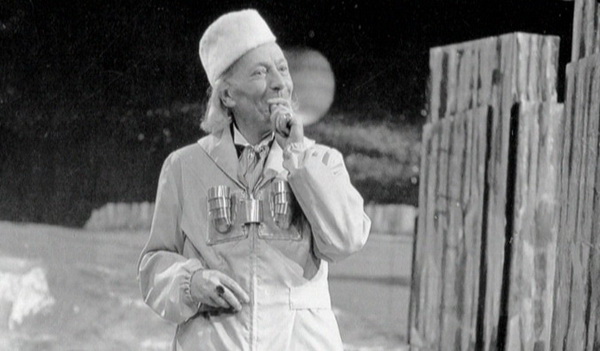
Turning to the regulars, Season 1 saw William Hartnell at his sternest,
and understandably so, having to cope with that miserable walking hankie
Susan. I think secretly he was waiting for her to make doe eyes at some
bloke so that he could lock her out sooner! Of course, in reality Carole
Ann Ford’s departure rocked Hartnell considerably, and saw the birth of
the brand new nutty Professor Doctor, an adorable and charming character
who enveloped his fellow travellers with a sense of security and warmth.
This is the first Doctor that I remember and he’s just ace. The Web
Planet sees this new Doctor as crazy as he was rude last year. The
first episode is vintage Hartnell, giggling at his own cleverness,
concerned about the ship but eager to explore and thrilled by the
adventure. Some of his lines (“I say, Chesterton. What you doing over
there? Come over here and learn something!”, “no pigeons,” and even better
“we nearly had the remains of a Coal Hill school teacher instead of this
wretched old, ragged old tie!”) are absolutely priceless. His chemistry
with Russell and Hill is gorgeous by now and just three stories in, the
Doctor and Vicki are already making a more formidable combination that the
Doctor and his granddaughter did.
And Ian and Barbara are just wonderful, aren’t
they? I don’t really care what they are doing; Hill and Russell manage to
make it look believable, and more importantly, enjoyable. Whilst the
Doctor is chuckling and aghast with wonder, it’s
left to Ian and Barbara to remind us how alien and terrifying this planet
is. Ian’s cautious attitude in the first episode is commendable, and
Barbara’s possession scares because, for once, the malignant influence has
extended into the safety of the TARDIS and ensnared one of our characters.
Vicki’s reaction to the out of control TARDIS is very credible, not only
because she is a freshman but as the very idea of the TARDIS being dragged
across the surface of Vortis, an evil force drawing it in, is very creepy
psychologically. I love Ian’s adventures underground, exploring beautiful
metaphors; Barbara’s baiting of Hillio, and the way that she pulls
the drippy Menoptra into action, once again proving why she was without
doubt the best of the original companions.
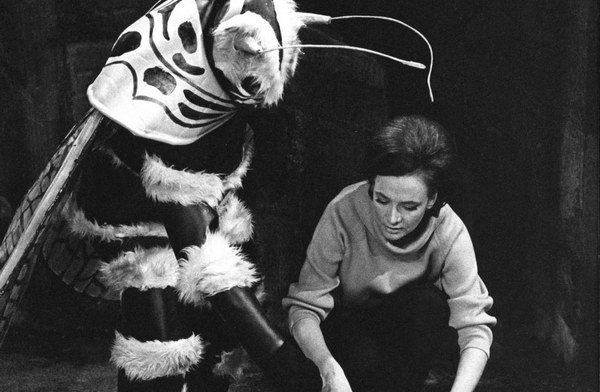
Maureen O’Brien nails it in the
Tales of Isop DVD documentary
-
the ideas in this story are truly innovative. A nasty cancerous evil at
the heart of a planet, influencing everything on the surface, drawing in
all the hate from the planet through its blood stream-like acid pools. The
fact that the Zarbi and Venom Grubs turns docile after the Animus is
destroyed reveals just how powerful its influence was.
Where this story fails is in its attempts to make the action dynamic. I
did chuckle a couple
of times during its six episodes, mostly when Richard Martin jettisoned
the idea to subtly explore this alien world, instead attempting to realise
a full-blooded ants versus moths war. Martin did not have the technology,
the resources, the time or the skill to pull this off as an action movie
with any kind of success. What you get is the Menoptra practically
standing
still so the Venom Grubs can shoot them, the Zarbi being manhandled off
their feet, and the Venom Grubs being picked up and squished against the
walls. The action looks stilted; it’s deathly slow in places, and the
shots of running Zarbi are enough to make you laugh yourself silly. That
said, the phallic protuberance that spits cobwebs all over the Doctor and
Vicki is more effective, and I really admire the moments where Martin
attempts to pan across the action, even if the action itself is awkward.
If it were my choice, I would have cut this story down to four episodes,
snipped out most of the action sequences and really pushed the
psychological terror.
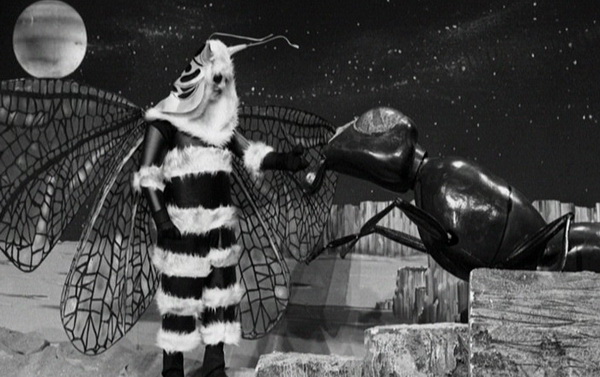
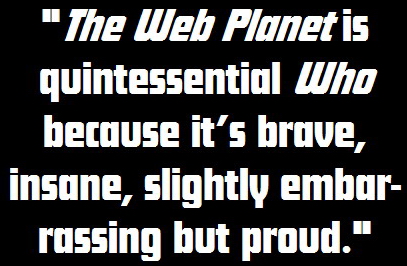 Simon
always amazes me when he
watches Doctor Who. He loves the
revived series, but then he adores
flashy fast moving television. I can
never anticipate what his reaction
to classic serials will be, which is
what makes us watching the show
together so enjoyable. A couple of
nights this week he has been happy
to watch The Web Planet with me,
even doing funny Menoptra hand
signals every time he asks me if I
want a cuppa. He thinks that Bill
Hartnell is the Doctor who adores
his
“hairdryer”
line. He will snap at Vicki, because he doesn’t
want her to end up like Susan.
He laughs at the Venom Grub who walks across the stage with the actors’
legs clearly visible underneath. He loves the madness of it all. And
he
thinks The Web Planet is quintessential Doctor Who because
it’s
brave, insane, slightly embarrassing but proud. Simon
always amazes me when he
watches Doctor Who. He loves the
revived series, but then he adores
flashy fast moving television. I can
never anticipate what his reaction
to classic serials will be, which is
what makes us watching the show
together so enjoyable. A couple of
nights this week he has been happy
to watch The Web Planet with me,
even doing funny Menoptra hand
signals every time he asks me if I
want a cuppa. He thinks that Bill
Hartnell is the Doctor who adores
his
“hairdryer”
line. He will snap at Vicki, because he doesn’t
want her to end up like Susan.
He laughs at the Venom Grub who walks across the stage with the actors’
legs clearly visible underneath. He loves the madness of it all. And
he
thinks The Web Planet is quintessential Doctor Who because
it’s
brave, insane, slightly embarrassing but proud.
I want more people to give The Web Planet a chance. It wants to be
a stunning tour de force of weirdness, and it has a fairly decent
stab at it. Every five minutes something silly happens, but equally every
five minutes something strange and fresh and utterly wonderful happens. It
is sheer insanity from beginning to end, but then that’s Doctor Who
for you. Brilliant, poetic, shocking and imaginative on the one hand;
childish, creaky, slow and under-resourced on the other. Six episodes of
schizophrenic heaven. Justice for Zarbi!
|